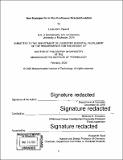| dc.contributor.author | Papa, Louis John,
III. | en_US |
| dc.contributor.other | Massachusetts Institute of Technology. Department of Chemistry. | en_US |
| dc.date.accessioned | 2021-10-15T15:29:19Z | |
| dc.date.available | 2021-10-15T15:29:19Z | |
| dc.date.copyright | 2020 | en_US |
| dc.date.issued | 2020 | en_US |
| dc.identifier.uri | https://hdl.handle.net/1721.1/132986 | |
| dc.description | Thesis: Ph. D., Massachusetts Institute of Technology, Department of Chemistry, February, 2020 | en_US |
| dc.description | Cataloged from the PDF version of thesis. | en_US |
| dc.description | Includes bibliographical references. | en_US |
| dc.description.abstract | Continuous in vivo directed evolution facilitates the exploration of large biomolecule libraries at unprecedented speeds. By inserting a biomolecule of interest into a constantly mutating virus whose replicative capacity has been rendered dependent on the desired activity of that biomolecule, the once-separate mutagenesis, selection, and amplification steps of directed evolution are integrated into one simultaneous, self-sustaining process. This strategy has the potential to greatly accelerate the study of evolutionary hypotheses and the development of new biotechnologies. Unfortunately, current iterations are difficult to implement and largely restricted to E. coli. Furthermore, mutation rates are limited by the lack of simple mutagenesis methods that can focus mutations to desired portions of a viral genome. In this thesis, I describe the development of several new continuous in vivo directed evolution strategies and tools that overcome current limitations and expand the methodology to human cells. Using a generalizable adenovirus-based continuous directed evolution system, we evolved, directly in human cells, multiple variants of the tTA transcription factor that gained resistance to their small molecule inhibitor and piloted selection couples for evolving complex biomolecule activities. This system enables the continuous directed evolution of biomolecules that are important to human health and that function within complex networks that are absent in E. coli. Furthermore, biotechnologies developed directly in mammalian cells are more likely to have optimal function than biomolecules that are evolved in E. coli and then transferred to the mammalian cellular context. We also developed an in vivo targeted mutagenesis method that focuses mutations to a carefully defined DNA region of variable size. Using fusions of various DNA damaging enzymes and the T7 RNA polymerase, achieved high mutation rates without the usual toxicity associated with off-target mutagenesis. We expect this mutagenesis technique to be applicable across a wide variety of organisms and particularly useful for viral-based continuous evolution platforms. Finally, we are currently developing a new continuous evolution strategy for use in E. coli cells utilizing the lambda bacteriophage. If successful, this system would be much easier to monitor and tune than previous systems, and would expand the biomolecule cargo capacity by an order of magnitude. | en_US |
| dc.description.statementofresponsibility | by Louis John Papa III. | en_US |
| dc.format.extent | 264 pages | en_US |
| dc.language.iso | eng | en_US |
| dc.publisher | Massachusetts Institute of Technology | en_US |
| dc.rights | MIT theses may be protected by copyright. Please reuse MIT thesis content according to the MIT Libraries Permissions Policy, which is available through the URL provided. | en_US |
| dc.rights.uri | http://dspace.mit.edu/handle/1721.1/7582 | en_US |
| dc.subject | Chemistry. | en_US |
| dc.title | New strategies for in vivo continuous directed evolution | en_US |
| dc.type | Thesis | en_US |
| dc.description.degree | Ph. D. | en_US |
| dc.contributor.department | Massachusetts Institute of Technology. Department of Chemistry | en_US |
| dc.identifier.oclc | 1263579467 | en_US |
| dc.description.collection | Ph.D. Massachusetts Institute of Technology, Department of Chemistry | en_US |
| dspace.imported | 2021-10-15T15:29:19Z | en_US |
| mit.thesis.degree | Doctoral | en_US |
| mit.thesis.department | Chem | en_US |
